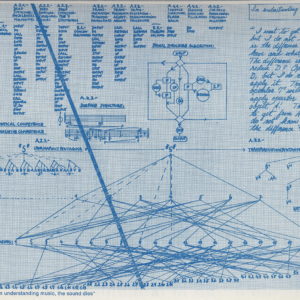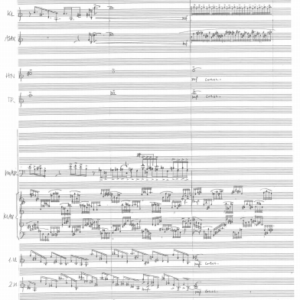Beschreibung
Aimide
für Klavier (1987/2001/02)
[pdf-embedder url=“http://beginner-press.de/wp-content/uploads/securepdfs/2017/09/Aimide_Score_Complete.pdf“]
„Amicitias immortales, mortales inimicitias debere esse.“ (Livius)
(Friendship should be imperishable, enmity should be perishable.)
By attempting to communicate a thought of Livius idea, AIMIDE aims counterbalance a fatal development in recent political discourse – the idea that the enemy must be demonized. One might consider the enemy, instead, as a reality to be approached with foresight and without distortion. Ennemies have always things in common, and these need to be searched out and seen. These have to be found and seen with clear vision.
Prolog:
Daimon
I
Cura
Cura means concern. This movement is written as a musical diary between the 12th of September 2001 and the end of the year. It is centered around the protest song „We shall overcome“ but also includes everyday moments of inspiration into its stream of consciousness.
II
Fuga
The third movement is a strict combinatorial processing of one pseudo-tonal melody (of twelve tones) through all 12 inversions retrogrades and retrograde-inversions. It’s static structure is a contrast to the virtuosic flow of the second movement, and it reminds us of two things: 1) we are all products of our cages 2) that there is no flight (Fuga) out of our own consciousness
III
Svara
Finally Svara is a transcription of Brahman chant-particles and a combination of two independent strata of these particles. suggests a fourth world (next to „Prelude“, „Toccata“, „Fugue“) the „Recitative“. Recitation is an ancient type of cultural expression, bridging wide cultural gaps and enhancing friendship.
Epilog:
Synastria
This movement is an ascetic reduction of the musical material to three pitches e – eflat – bflat, distributed throughout the registers of the piano in artistic velocity. The b-flat, sustained by use of the third pedal, is a common reference, like the common star of two dissonantly related pitches (the interval of a minor second between e and e flat). This serves as an analogy that ennemies share common denominators. It also trusts in an ancient thought that a philosophical idea can be expressed through music.
for Herbert Henck (I&II) & Thomas Schultz (III&IV)
commissioned by the Stanford University (Smith Piano Fund)
„Amicitias immortales, mortales inimicitias debere esse.“ (Livius)
(Freundschaft sollte unvergänglich sein, Feindschaft sollte vergänglich sein.)
I
Cura bedeutet Sorge. Dieser Satz wurde als musikalisches Tagebuch zwischen dem 12. September 2001 und dem Jahresende geschrieben. Es dreht sich um das Protestlied „Wes hall overcome“, bezieht aber auch alltägliche Momente in seinen Bewusstseinsstrom ein.
II
Fuga ist eine streng kombinatorische Verarbeitung einer pseudo-tonalen Melodie (von zwölf Tönen) durch alle 12 Inversionen, Retrograden und Retrograden-Inversionen. Die statische Struktur steht im Gegensatz zum virtuosen Fluss des ersten Satzes und erinnert uns an zwei Dinge: 1) Wir sind alle Produkte unserer Käfige. 2) Es gibt keine Flucht (Fuga) aus unserem eigenen Bewusstsein.IIISvara ist eine Transkription von brahmanischen Gesangspartikeln und eine Kombination von zwei unabhängigen Schichten dieser Partikel. Eine dritte Welt (neben „Präludium“ und „Fuge“) schlägt das „Rezitativ“ vor. Rezitation ist eine uralte Form des kulturellen Ausdrucks, die große kulturelle Lücken schließt und die Freundschaft fördert.
III
Svara ist eine Transkription von brahmanischen Gesangspartikeln und eine Kombination von zwei unabhängigen Schichten dieser Partikel. Eine dritte Welt (neben „Präludium“ und „Fuge“) schlägt das „Rezitativ“ vor. Rezitation ist eine uralte Form des kulturellen Ausdrucks, die große kulturelle Lücken schließt und die Freundschaft fördert.
Version ohne Prolog/ Epilog:
[pdf-embedder url=“http://beginner-press.de/wp-content/uploads/securepdfs/2019/09/AIMIDE-senza-Pro-Epilogue.pdf“ title=“AIMIDE senza Pro-& Epilogue)“]
https://youtu.be/aWp9dH4Xjps




